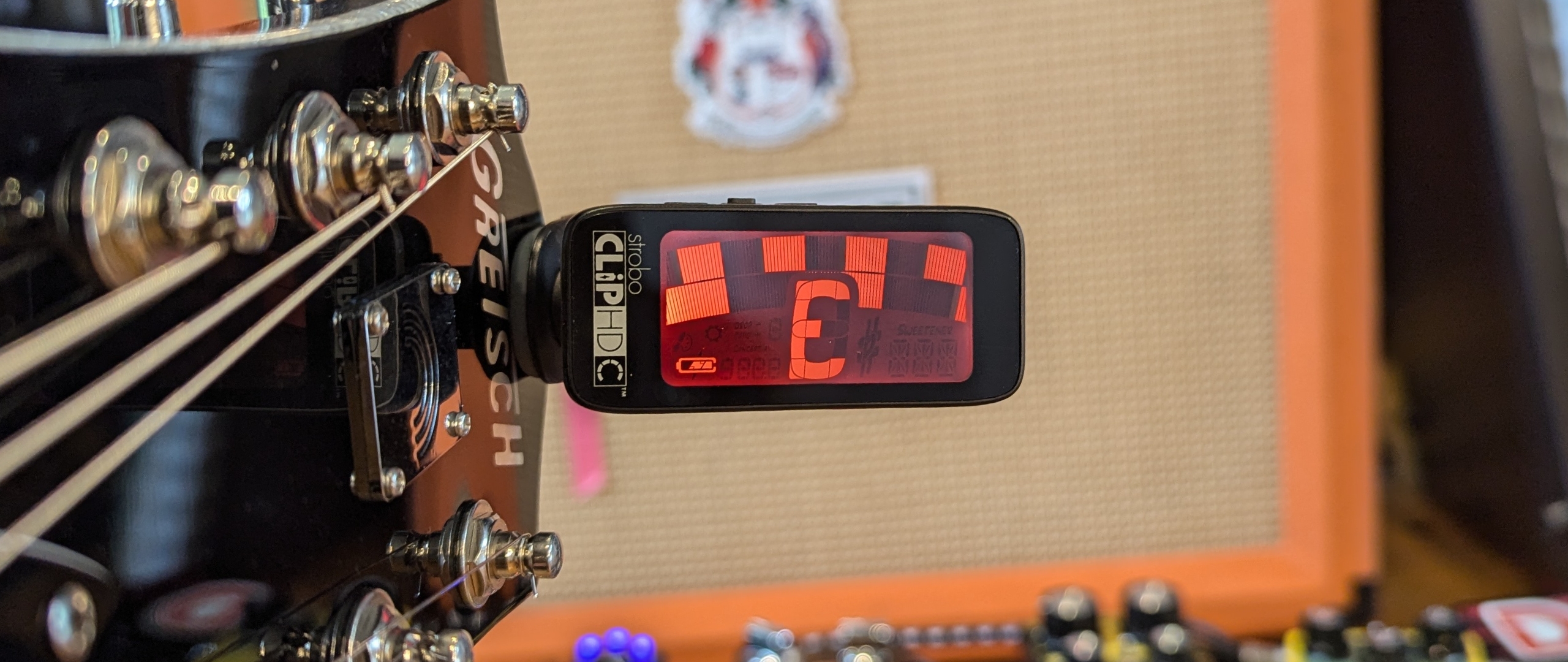MusicRadar Verdict
If you’re willing to stump up the cash, there’s no doubt that the Peterson Stroboclip HDC is one of the most fully featured clip-on tuners on the market. While the accuracy and depth are second to none, that price point will ultimately prove divisive.
Pros
- +
Accurate to an incredible 0.01 cent
- +
Over 50 ‘sweetened’ tunings
- +
Colour customization options
- +
A lot of depth here for a tuner
Cons
- -
Eye-watering entry price
- -
Overkill for a lot of players
MusicRadar's got your back
I can’t imagine clip-on tuners are the sort of thing most guitarists spend a long time thinking about. Over the years I must’ve picked up at least five of them, and to be totally transparent most of them are sitting in a drawer somewhere. So when I was asked to review the most expensive clip-on tuner I've ever come across, there was definitely a part of me that was more than skeptical.
The Peterson Stroboclip HDC costs a pretty penny, with an RRP around $/£80. For reference, a Boss TU-3 - arguably the most popular and durable guitar tuner ever made - is only $/£20 more, and can be had on sale and secondhand for much less than that. Even the TC Electronic PolyTune Clip can be had for a similar price with its unique polyphonic tuning capabilities.
So what makes the Stroboclip worth such an eyebrow-raising fee? With one attached to my trusty Telecaster, I dove into its features and abilities to find out, and ascertain whether it’s really worth that expenditure. Let’s get to it.
Peterson Stroboclip HDC review: Features
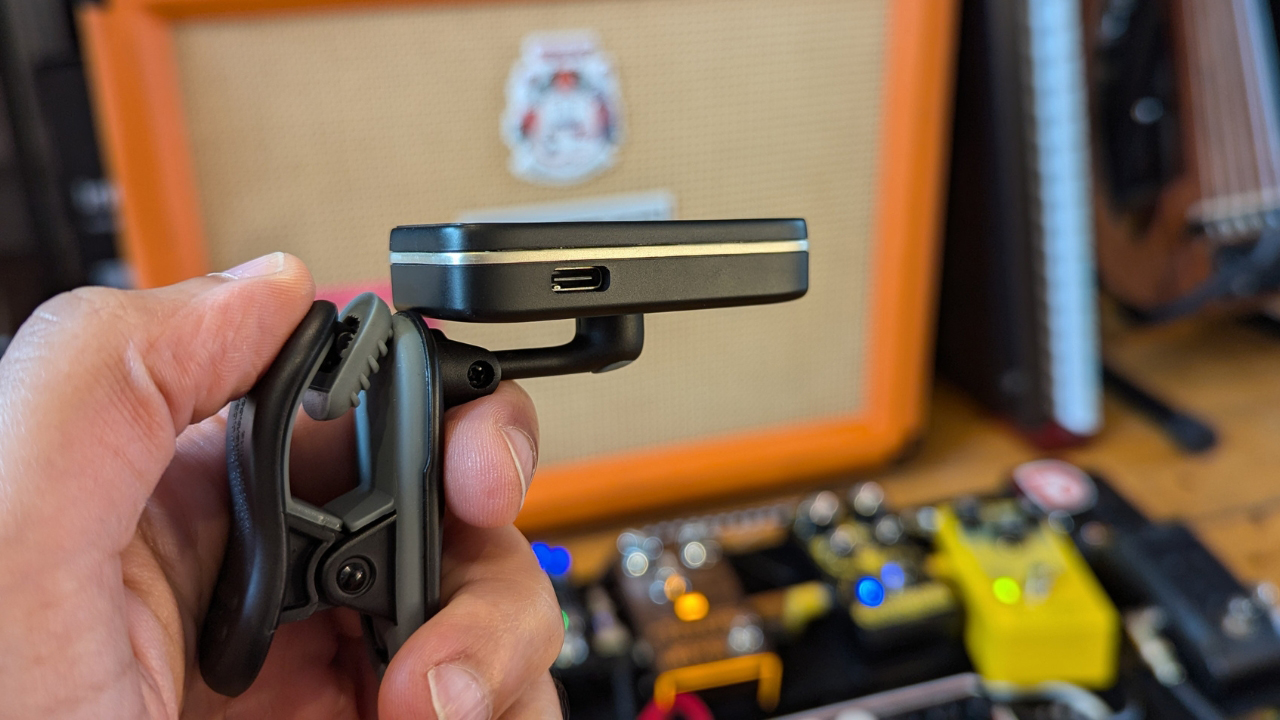
The headline feature of Stroboclip HDC for me is that 0.1-cent tuning accuracy. It’s the smallest figure I’ve seen of any clip-on tuner on the market and puts it well in line with much more expensive pedalboard and rack-mounted tuners. It also tracks all the way down to 16Hz, so should handle tuning a five-string bass without issue.
It’s got an assuring 6 hours of battery life and is rechargeable via USB-C, so no digging around for older cables in a drawer. A bright LCD screen ensures visibility in all conditions and you can select various colours for the display too, which will likely be a godsend for any guitarists afflicted by colourblindness.
Something totally unique to the Stroboclip are its ‘sweetened’ tunings, which do away with classic equal temperament tuning where every string is tuned by intervals. With a ‘sweetened’ tuning each string is slightly flat or sharp to account for the intonation of that particular instrument.
Peterson Stroboclip HDC review: Performance
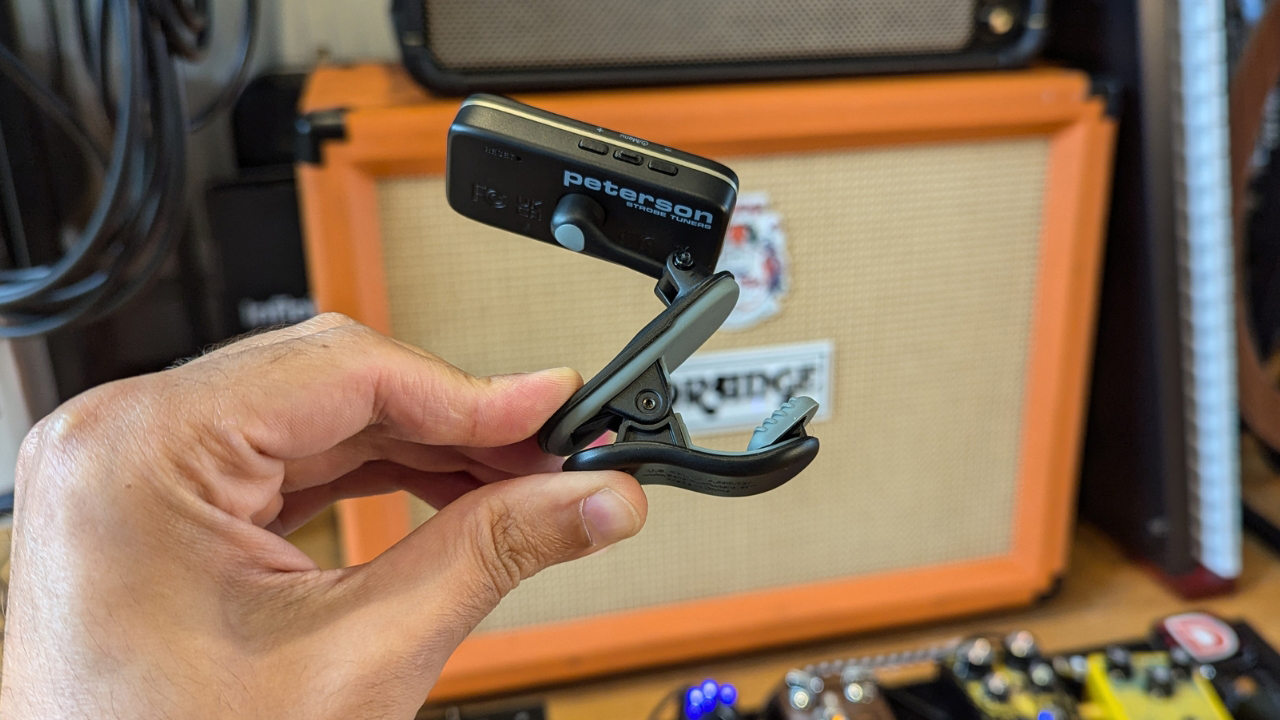
I’ve never used a strobe tuner before despite having played guitar for well over 20 years. It’s a weird feeling being totally stumped looking at the display of a tuner, but that’s exactly the situation I found myself in when I switched on the Peterson Stroboclip HDC. Rather than a note and some up and down arrows, the display shows what I can only describe as a portion of a two-tier roulette wheel.
Want all the hottest music and gear news, reviews, deals, features and more, direct to your inbox? Sign up here.
The idea is to get the wheel to stop moving, and the direction of the spin determines whether the note is sharp or flat. If it’s moving to the right you need to tune up and vice versa. It’s initially baffling, but not too hard to get your head around once you’ve had a few goes with it. The idea is you’re not limited by the amount of LEDs the tuner has, making the moving wheel more accurate.
Did I find my guitar more in tuner versus my regular pedalboard-mounted tuner? Well, the truth is at these tiny increments you can’t really tell the difference. I didn’t feel like my guitar was more in tune than usual, but there is that unspoken reassurance that you know you’re not slightly sharp or flat. I have a heavy right hand so tend to tune my low string slightly flat to accommodate for that, and this is definitely made easier by this style of tuner.
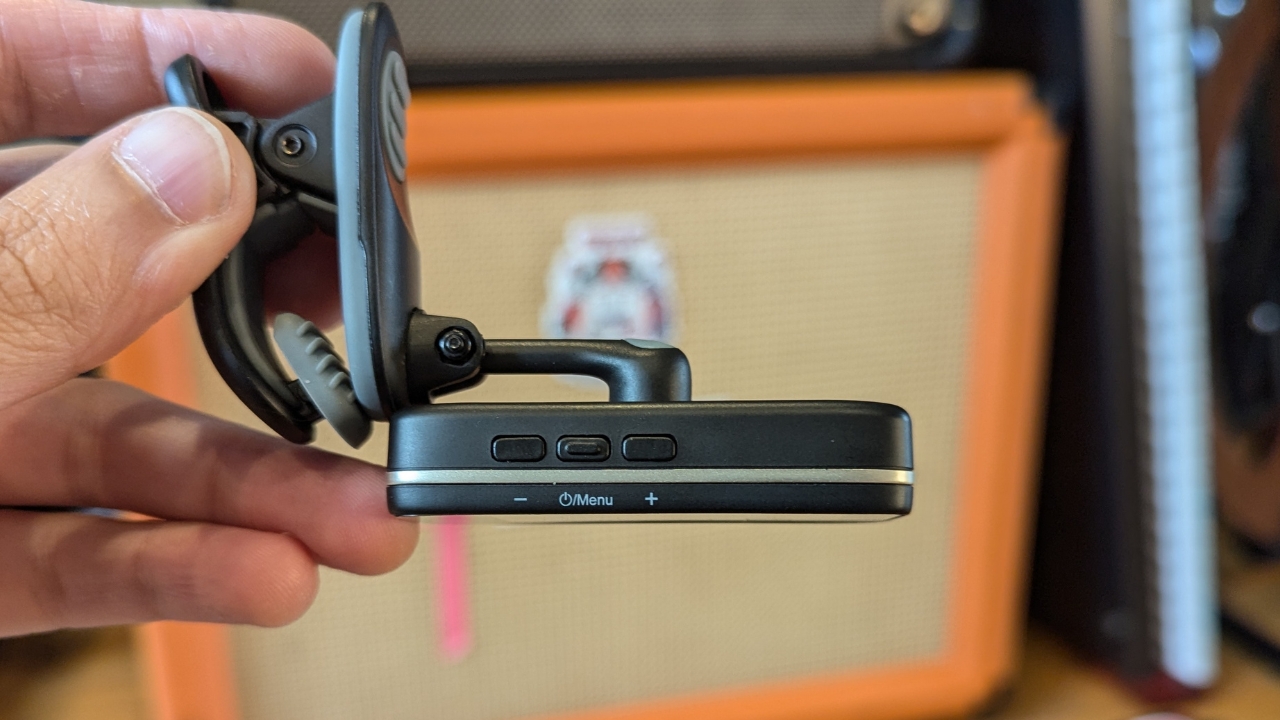
The Stroboclip is super easy to use too, thanks to the three buttons mounted on the side. The middle one is ridged making it easy to find on a dimly lit stage and acts as a power button as well as allowing you to cycle through the options. The ones on either side let you scroll through the various options, whether you’re diving into the ‘sweetened’ tunings or adjusting your tuning for a capo.
Moving onto the ‘sweetened’ tunings I set it to electric guitar mode and gave it a go with my Tele. After playing a bunch of chords and single note licks, I’ll admit I couldn’t find much difference to my ear. It all sounded just as good as when I had it in regular tuning mode. Ditto when I tried it with my Taylor GS-Mini. Nothing sounded off, but nothing sounded different either.
Perhaps my ears are not sensitive enough to these small changes, or perhaps it's a mode better suited to the orchestral instruments included in the list. It might be you’ll get a different result with your particular instrument and there’s no doubt the huge amount of instruments on offer could prove useful to those with expansive collections or specialist stringed instruments.
The colour options are a nice touch, and I opted for a nice bright green that provided the right contrast for my own eyes. There are ten colour presets, and you can even create your own specific colour blend. You can also customize the tuner so it changes colour when you select regular tuning or a ‘sweetened’ tuning mode, which could prove handy for those who are switching between instruments regularly.
Peterson Stroboclip HDC review: Final verdict
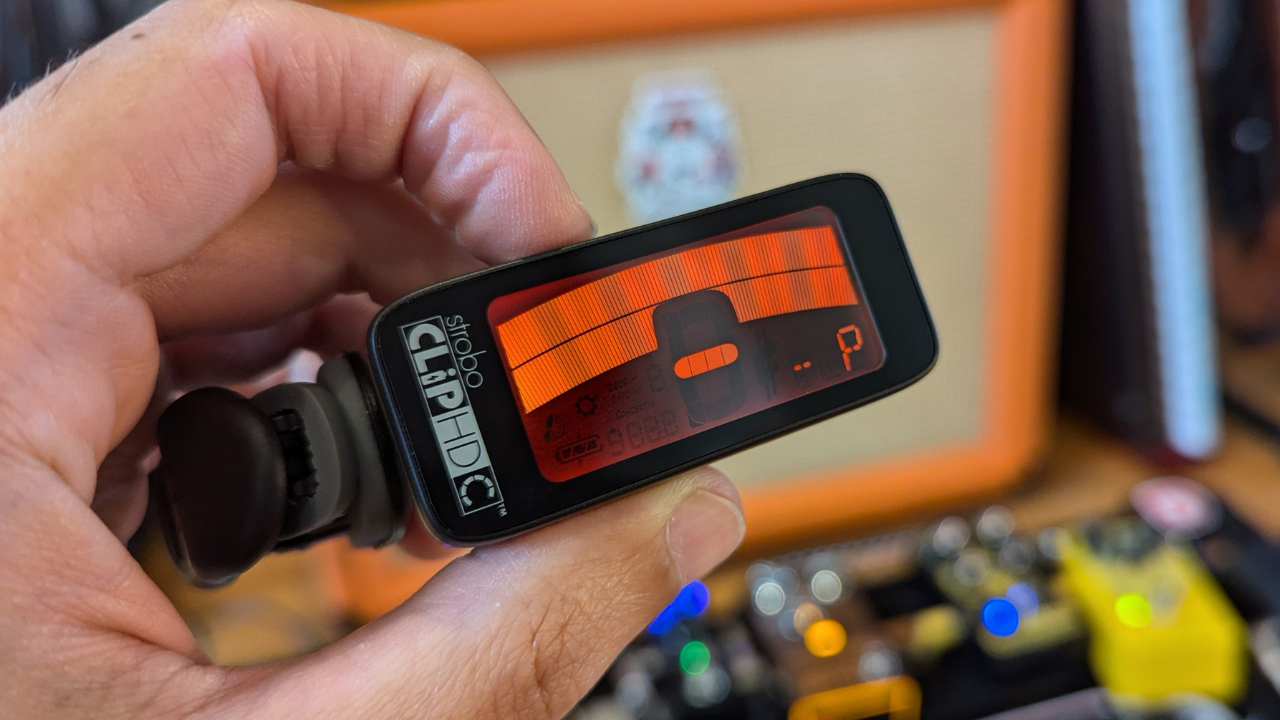
My only real qualm with the Peterson Stroboclip HDC is the price. It works fantastically well, offers a huge amount of options for all players of stringed instruments, and provides the highest accuracy available for any clip-on tuner. Whether or not you’re willing to pay the premium for such features? Well that's entirely up to you.
Peterson Stroboclip HDC review: Specs
- Price: $79.99/£79/€89
- Type: Strobe
- Format: Clip-on
- Display Type: Strobe, HD backlit LCD
- Reference Pitch: Concert A = 390Hz-490Hz
- Tuning Range: C0-B6 (16-1975Hz)
- Accuracy: 0.1 cent
- Tuning Modes: 50+ Tuning Modes
- Inputs: Piezo sensor pickup
- Contact: Peterson Tuners

Matt is a Junior Deals Writer here at MusicRadar. He regularly tests and reviews music gear with a focus on audio interfaces, studio headphones, studio monitors, and pretty much anything else recording-related. Matt worked in music retail for 5 years at Dawsons Music and Northwest Guitars and has written for various music sites including Guitar World, Guitar Player, Guitar.com, Ultimate Guitar, and Thomann’s t.blog. A regularly gigging guitarist with over 20 years of experience playing live and producing bands, he's also an alumnus of Spirit Studios, where he studied studio engineering and music production.
